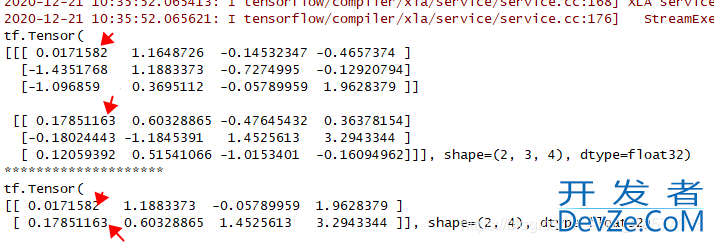使用tf.keras.MaxPooling1D出现错误问题及解决
目录
- 使用tf.keras.MaxPooling1D出现错误
- 错误如下
- 首先了解MaxPooling1D
- 出现错误原因
- 其他人的处理方法
- 我的处理方法
- MaxPooling1D和GlobalMaxPooling1D区别
- 总结
使用tf.keras.MaxPooling1D出现错误
错误如下
ValueError: Negative dimension size caused by subtracting 2 from 1 for 'pool_2/MaxPool' (op: 'MaxPool') with input shapes: [?,1,1,32].
首先了解MaxPooling1D
tf.layers.max_pooling1d( inputs, pool_size, strides, padding='valid', data_format='channels_last', name=None )
用于1维输入的MaxPooling层
pool_size:表示pooling window的大小strides:指定pooling操作的步长padding:一个字符串。padding的方法:string,valid或same,大小写不敏感。data_format:一个字符串,channels_last(默认)或channels_first中的一个,输入中维度的排序,chwww.devze.comannels_last对应于具有形状(BATch, length, channels)的输入,而channels_first对应于具有形状(batch, channels, length)的输入。name:一个字符串,表示层的名称。
出现错误原因
是图片通道的问题,也就是”channels_last”和”channels_first”数据格式的问题。
input_shape=(3,28,28)是theano的写法,而tensorflow需要写出:(28,28,3)
其他人的处理http://www.devze.com方法
查了很多方法我的问题都没有解决:
法一:配置.keras下的keras.json文件,将channels_last修改为channels_first
{
"image_data_format"编程客栈 : "channels_first",
"epsilon": 1e-07,
"floatx": "float32",
"backend": "tensorflow"
}
法二:在运行代码前面加两行代码:
from keras import backend as K
K.set_image_dim_ordering('tf')
我的处理方法
直接在出现错误的代码中补充一个参数,加上data_format='channels_first'就可以啦,,
pool_4 = MaxPooling1D(pool_size=2, name='pool_4',data_format='channels_first')(conv_4)
注:此方法适用MaxPooling2Djavascript
MaxPooling1D和GlobalMaxPooling1D区别
import tensorflow as tf
from tensorflow import keras
input_shape = (2, 3, 4)
x = tf.random.normal(input_shape)
print(x)
y=keras.layers.GlobalMaxPool1D()(x)
print("*"*20)
print(y)
'''
"""Global average pooling operation for temporal data.
Examples:
>>>编程客栈 input_shape = (2, 3, 4)
>>> x = tf.random.normal(input_shape)
>>> y = tf.keras.layers.GlobalAveragePooling1D()(x)
>>> print(y.shape)
(2, 4)
Arguments:
data_format: A string,
one of `channels_last` (default) or `channels_first`.
The ordering of the dimensions in the inputs.
`channels_last` corresponds to inputs with shape
`(batch, steps, features)` while `channels_first`
corresponds to inputs with shape
`(batch, features, steps)`.
Call arguments:
inputs: A 3D tensor.
mask: Binary tensor of shape `(batch_size, steps)` indicating whether
a given step should be masked (excluded from the average).
Input sha开发者_开发教程pe:
- If `data_format='channels_last'`:
3D tensor with shape:
`(batch_size, steps, features)`
- If `data_format='channels_first'`:
3D tensor with shape:
`(batch_size, features, steps)`
Output shape:
2D tensor with shape `(batch_size, features)`.
"""
'''
print("--"*20)
input_shape = (2, 3, 4)
x = tf.random.normal(input_shape)
print(x)
y=keras.layers.MaxPool1D(pool_size=2,strides=1)(x) # strides 不指定 默认等于 pool_size
print("*"*20)
print(y)
输出如下图 上图GlobalMaxPool1D 相当于给每一个样本每列的最大值

而MaxPool1D就是普通的对每一个样本进行一个窗口(1D是一维列窗口)滑动取最大值。
总结
以上为个人经验,希望能给大家一个参考,也希望大家多多支持我们。






 加载中,请稍侯......
加载中,请稍侯......
精彩评论